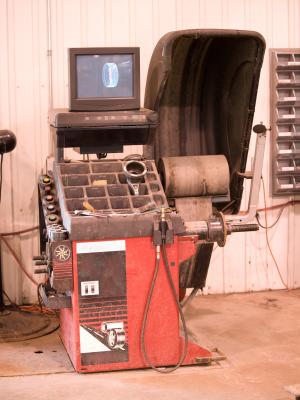
When tires are replaced, one of the processes that they should be put through is balancing. To balance tires, you need a wheel-balancing machine. After a new tire is put on the wheel, it is moved from the regular tire machine to the balancer. This tests for imbalances that could cause wheel wobble or vibration once the wheel is put back on the car.
The static balancer is the oldest type of wheel-balancing machine. Most shops rely on more modern equipment to balance wheels, but a few shops with mechanics who learned their craft years ago still use them. A wheel is placed on a cone that tips in the direction where the wheel is too heavy. An air bubble in a sight, similar to the bubble in a carpenter's level, deflects away from the heavy spot. The worker then corrects the balance with wheel weights until the cone is straight and the bubble level.
Dynamic balancers spin the wheels while checking the balance. The wheel sits on a machine that spins the tire and wheel quickly to generate spin similar to what the wheel experiences on the road. Dynamic balancers utilize computers to determine how off-balance a wheel is. The exact measurements of the wheel are taken and input into the machine. Then, the spinning begins and readings are taken that tell the repair person where to apply wheel weights to fix any imbalances read by the sensors during wheel spin.
Another type of dynamic balancer operates on the wheels while they are still on the car. The machine attaches to the wheel and spins it while taking readings regarding the balance. These machines often spin at higher speeds than off-car balancers. This more closely replicates actual road conditions and sometimes detects balance issues that other types of machines miss.
Once the tire professional sees how the tire is out of balance, he needs to correct it. Normally, this is done through the use of wheel weights. These are small weighted clips that snap on to the rim of your wheel. The mechanic adds weights to the off-balance side of the wheel until the balancing machine shows a perfectly balanced tire.